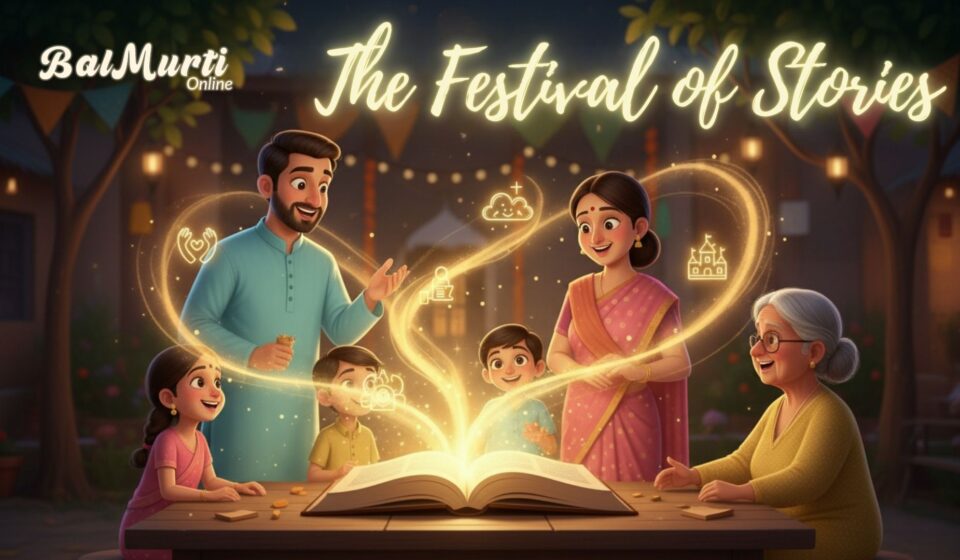We told our daughter Astha her first story when she was two years and nine months old. She listened. She understood. She was interested. And honestly, that surprised us.
Table Of Content

We thought we were late. At the time, it felt like we were a year behind. Now I know there’s no such thing as being early or late when it comes to stories. A story can begin with a lullaby, with a smile, with a whisper. It fits right into the everyday language a mother speaks to her baby. You don’t need to follow a manual or wait for a milestone. You just need to understand your child.
Books will offer all kinds of timelines. But no book can give you a better answer than the child in front of you. Read the child. Understand the child. That’s where it all begins.
The Story Thread

With Astha, that first story turned into a nightly routine. To say we had to tell stories wouldn’t be quite right. I loved it just as much as she did. We began experimenting. I’d ask her to choose a topic, and I’d spin a tale around it.
Without meaning to, every story I told had the same thread; kindness, compassion, friendship, honesty. There were no villains, no trickery. Everyone helped each other. The more I learned about parenting through Astha, the clearer it became: even the creators of children’s literature don’t always get it right. Sometimes the stories we hand our kids are filled with jealousy, rivalry, selfishness, and violence instead of the values we want them to grow up with.
A Child’s Storytelling Is Its Own Kind of Magic

When Astha turned three and a half, I started asking her to tell stories too. What came out of her was pure creativity. Character after character. Scene after scene. Emotion, drama, dialogue. No structure, no ending; just expression in its rawest, most beautiful form. And even in her stories, I saw it: love, honesty, harmony.
People often complain that children are quick to fight or lie. Some blame TV. Some blame toys. But it’s often the stories we feed them; even so-called “children’s” stories; that sneak in the seeds of fear, competition, and aggression.
We subscribed to four magazines for her. Chandamama was one of them. But we stopped it. It didn’t align with our values.
You can filter what they read and watch, but the real insight comes from talking to your child. That’s where you learn whether they’re absorbing what truly matters.
Children Are Always Observing
Don’t think they’re just listening to the story. They’re also watching the storyteller. Parents need to be more alert; because the younger the child, the sharper their lens.
Here’s an example.

Astha wanted to watch a movie. I’d heard that Do Aankhen Barah Haath was a great film. I got the CD. She watched for a few minutes and said, “Papa, there’s too much fighting in this. I don’t want to see it.”
Another day, I was reading her Hindi textbook. The story opened with gunshots; hunters chasing a partridge. She stopped me and said, “Papa, there’s violence in this. But don’t worry, it’s a good story in the end.”
This, from a child under ten. That kind of sensitivity doesn’t just happen. It comes from years of emotional nourishment’ of choosing what to show, what to say, and what not to pass off as “just a story.”
The Missed Moments

Astha’s stories were so delightful, we thought of recording them. We didn’t. Two years passed. Then we bought a recorder. Another two years passed. The time, as always, flew.
We once played Gandhiji’s autobiography in the car. She loved it. Listened silently, chapter after chapter, until we reached the seventeenth. Then the CD got lost. It took us ten months to replace it. When we finally did, she didn’t want to hear it at home. “We’ll only listen in the car,” she said.
And that’s the thing. If you want to shape a child, you have to seize the moment; because once it passes, it may not come back.
Stories That Stay
Astha still wants a story every day. I’ve run out of them. I keep thinking I’ll read something new and tell her, but I don’t. We have plenty of books at home. I read aloud sometimes. But not regularly.

Let’s be honest; it’s not that I can’t. It’s that I don’t. When we say we “can’t find time,” what we really mean is we haven’t made it a priority. If I had to go to work, I wouldn’t say, “I wanted to go, but it didn’t happen.” I’d go. The same rule applies to parenting.
Mulshankar Bhatt, house father at Dakshinamurti Hostel, once translated several respected English books into Gujarati; just so he could tell stories to children at prayer time.
If parenting becomes your priority, your child’s childhood won’t slip away from you.
The Clock Is Ticking
Poet Vinod Joshi once shared a lovely parenting moment. When his son Aditya was three, he’d ask him to tell a story; and he’d set a timer. When the story ran out but the time didn’t, Aditya had to get creative. Improvise. Stretch his thoughts.

Vinodbhai told me this twice. That says something. These memories; small, but vivid; stay with us. Parents who miss out on these moments may never get another chance.
Even if your child never sends you to an old-age home, your house might start to feel like one. A life with no stories to look back on is a life that starts to feel… empty.
Story as a Tool, Not a Luxury
I often used stories to explain everyday things. Like vegetables.
Once, I told her this:
Goddess Parvati had given Ganesha and Kartikeya bowls of honey. Ganesha turned up his nose. “I don’t like it,” he said. Parvati told him to taste it before deciding.
He refused. Lord Shankar got upset. He gave Ganesha’s bowl to Kartikeya instead. Kartikeya ate from both.

Ganesha, watching, licked a little honey off the side. And realized it was delicious. The lesson was simple: never say no before trying something.
To this day, I use that story when she refuses to eat something new.
Stories aren’t just entertainment. They’re tools for parenting. For value building. For developing taste; in food, in literature, in life. A child who listens to stories develops an interest in reading. A child who reads doesn’t need much teaching. Learning unfolds on its own. Sensitivity follows. So do values.
That child becomes a light; not just for your home, but for the world.
Where Do We Begin?

Start with teachers. Storytelling should be a part of every school’s curriculum. Even in higher classes, tough concepts can be taught through stories. The most successful speakers and trainers use stories as their foundation. That’s not a coincidence.
Instead of gifting heavy books on child development, gift new parents a set of beautiful storybooks. Watch what happens.
Because once you build a bridge through stories, the child will walk across it. You don’t need to push. You just need to open the path.
A Note to Parents and Teachers
It’s not enough to know stories. You have to know how to tell them. That’s an art. One worth cultivating.
The reason storytelling camps exist for children is because adults haven’t done their job. Really, those camps should be for parents and teachers. Fortunately, some places are catching on. Like Lokbharati in Bhavnagar, where storytelling camps for adults are held regularly.
Let me end with this: the world doesn’t need more festivals of water. It needs a festival of stories.

Because a child raised on stories; good ones; doesn’t need to be taught values. They’re already growing inside.
Disclaimer : This article reflects the personal views and lived experiences of the author. As a publication, we share this piece to spark meaningful reflection among parents, teachers, and caregivers. We may not necessarily endorse every perspective presented here.




